Abstract
A multi-objective optimized noise reduction design strategy for aircraft cabins was formulated and a mathematical model of multi-objective structural optimization was established based on the dynamic response and acoustic radiation equations of the structure. Later, the finite element and statistical energy analysis of the simplified hybrid simulation model of the aircraft cabin section was conducted to identify noise sources in aircraft cabin under different excitation conditions. A multistage optimization task was set up using the collaborative optimization algorithm, and an overall optimization process was designed for multi-objective optimization calculation and analysis. Results were compared with non-optimized results to verify the validity of the proposed optimization algorithm. Calculated results demonstrated that the proposed multi-objective optimized design can reduce sound pressure in aircraft cabin effectively, with an average reduction of 3–4 dB in the intermediate-frequency band.






Similar content being viewed by others
References
Aloufi, B., Behdinan, K., & Zu, J. (2016). Theoretical vibro-acoustic modeling of acoustic noise transmission through aircraft windows. Journal of Sound and Vibration, 371, 344–369.
Zverev, A. Y. (2016). Noise control mechanisms of inside aircraft. Acoustical Physics, 62(4), 478–482.
Efimtsov, B. M., & Lazarev, A. (2012). A complex of analytical models for predicting noise in an aircraft cabin. Acoustical Physics, 58(4), 404–410.
Baklanov, V. S. (2016). Role of structural noise in aircraft pressure cockpit from vibration action of new-generation engines. Acoustical Physics, 62(4), 456–461.
MacMartin, Douglas G. (1996). Collocated structural control for reduction of aircraft cabin noise. Journal of Sound and Vibration, 190(1), 105–119.
Yan, Y. J., Li, P. B., & Lin, H. G. (2016). Analysis and experimental validation of the middle-frequency vibro-acoustic coupling property for aircraft structural model based on the wave coupling hybrid FE-SEA method. Journal of Sound and Vibration, 371, 227–236.
Hall, A., Mayer, T., Wuggetzer, I., & Childs, P. R. N. (2013). Future aircraft cabins and design thinking: optimisation vs. win-win scenarios. Propulsion and Power Research, 2(2), 85–95.
Gardi, A., Sabatini, R., & Ramasamy, S. (2016). Multi-objective optimization of aircraft flight trajectories in the ATM and avionics context. Progress in Aerospace Sciences, 83, 1–36.
Bravo, T., Maury, C., & Pinhède, C. (2014). Optimising the absorption and transmission properties of aircraft microperforated panels. Applied Acoustics, 79, 47–57.
Paz, J., Díaz, J., Romera, L., et al. (2015). Size and shape optimization of aluminum tubes with GFRP honeycomb reinforcements for crashworthy aircraft structures. Composite Structures, 133, 499–507.
Stanef, D. A., Hansen, C. H., & Morgans, R. C. (2004). Active control analysis of mining vehicle cabin noise using finite element modelling. Journal of Sound and Vibration, 277(1–2), 277–297.
Haase, T., Unruh, O., Algermissen, S., et al. (2016). Active control of counter-rotating open rotor interior noise in a Dornier 728 experimental aircraft. Journal of Sound and Vibration, 376, 18–32.
Mallardo, V., Aliabadi, M. H., Brancati, A., et al. (2012). An accelerated BEM for simulation of noise control in the aircraft cabin. Aerospace Science and Technology, 23(1), 418–428.
Isakari, H., Kondo, T., Takahashi, T., et al. (2017). A level-set-based topology optimisation for acoustic–elastic coupled problems with a fast BEM-FEM solver. Computer Methods in Applied Mechanics and Engineering, 315, 501–521.
D’Amico, R., Neher, J., Wender, B., et al. (2012). On the improvement of the solution accuracy for exterior acoustic problems with BEM and FMBEM. Engineering Analysis with Boundary Elements, 36(7), 1104–1115.
Shorter, P. J., & Langley, R. S. (2005). On the reciprocity relationship between direct field radiation and diffuse reverberant loading. Journal of the Acoustical Society of America, 117(1), 85–95.
Reynders, E., Langley, R. S., & Dijckmans, A. (2014). A hybrid finite element-statistical energy analysis approach to robust sound transmission modeling. Journal of Sound and Vibration, 333(19), 4621–4636.
Cicirello, A., & Langley, R. S. (2014). Efficient parametric uncertainty analysis within the hybrid finite element/statistical energy analysis method. Journal of Sound and Vibration, 333(6), 1698–1717.
Muller, G., & Buchschmid, M. (2014). Hybrid approaches for vibroacoustical problems based on the finite element method and statistical energy analysis. Wave Motion, 51(4), 622–634.
Wang, Y. L., Qin, X. P., Huang, S., et al. (2017). Structural-borne acoustics analysis and multi-objective optimization by using panel acoustic participation and response surface methodology. Applied Acoustics, 116, 139–151.
Beigmoradi, S., Hajabdollahi, H., & Ramezani, A. (2014). Multi-objective aero acoustic optimization of rear end in a simplified car model by using hybrid robust parameter design, artificial neural networks and genetic algorithm methods. Computers & Fluids, 90, 123–132.
Li, W., Jia, Y. J., Wen, Y., et al. (2016). An improved collaborative optimization for multidisciplinary problems with coupled design variables. Advances in Engineering Software, 102, 134–141.
Yang, L. X., Qi, J. G., Li, S. K., et al. (2016). Collaborative optimization for train scheduling and train stop planning on high-speed railways. Omega, 64, 57–76.
Acknowledgements
This work was financially supported by the National Natural Science Foundation of China (Grant No. 11404205) and the Fundamental Research Funds for the Central Universities of Ministry of Education of China (Grant No. GK201703015).
Author information
Authors and Affiliations
Corresponding author
Rights and permissions
About this article
Cite this article
Gao, J., Qiang, N. Multi-objective Optimized Design for Intermediate-Frequency Noise Reduction in Aircraft Cabins. Wireless Pers Commun 102, 3737–3747 (2018). https://doi.org/10.1007/s11277-018-5405-2
Published:
Issue Date:
DOI: https://doi.org/10.1007/s11277-018-5405-2




